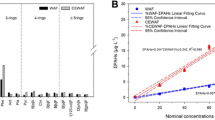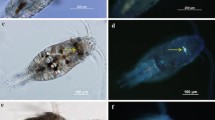Abstract
In order to examine the effects of crude oil and dispersed crude oil (DCO) on the swimming ability of puffer fish, Takifugu rubripes, the critical swimming speeds (U crit) of fish exposed to different concentrations of water-soluble fraction (WSF) of crude oil and DCO solution were determined in a swimming flume. WSF and DCO significantly affected the U crit of puffer fish (p < 0.05). The U crit of puffer fish exposed to 136 mg L−1 WSF and 56.4 mg L−1 DCO decreased 48.7 % and 43.4 %, respectively. DCO was more toxic to puffer fish than WSF. These results suggested that crude oil and chemically dispersed oil could weaken the swimming ability of puffer fish.

Similar content being viewed by others
References
Agamy E (2012) Histopathological liver alterations in juvenile rabbit fish (Siganus canaliculatus) exposed to light Arabian crude oil, dispersed oil and dispersant. Ecotoxicol Environ Saf 75:171–179
Anderson JA, Kuhl AJ, Anderson AN (2014) Toxicity of oil and dispersed oil on juvenile mud crabs, Rhithropanopeus harrisii. Bull Environ Contam Toxicol 92:375–380
Brauner CJ, Iwama GK, Randall DJ (1994) The effect of short-duration seawater exposure on the swimming performance of wild and hatchery-reared juvenile coho salmon (Oncorhynchus kisutch) during smoltification. Can J Fish Aquat Sci 51:2188–2194
Brett JR (1964) The respiratory metabolism and swimming performance of young sockeye salmon. J Fish Res Board Can 21:1183–1226
Canevari GP (1978) Some observations on the mechanism and chemistry aspects of chemical dispersion. In: McCarthy LT, Lindblom GP, Walter HF (eds) Chemical dispersants for the control of oil spills. American Society for Testing and Materials, Philadelphia, pp 2–5
Chinese National Environmental Protection Standard-Water quality-Determination of petroleum oils and animal and vegetable oils-Infrared spectrophotometry (HJ 637-2012). Ministry of Environmental Protection of the People’s Republic of China. Beijing China
Cohen JH, McCormick LR, Burkhardt SM (2014) Effects of dispersant and oil on survival and swimming activity in a marine copepod. Bull Environ Contam Toxicol 92:381–387
Couillard CM, Lee K, Légaré B, King TL (2005) Effect of dispersant on the composition of the water-accommodated fraction of crude oil and its toxicity to larval marine fish. Environ Toxicol Chem 24:1496–1504
De Boeck G, van der Ven K, Hattink J, Blust R (2006) Swimming performance and energy metabolism of rainbow trout, common carp and gibel carp respond differently to sublethal copper exposure. Aquat Toxicol 80:92–100
Duarte RM, Honda RT, Val AL (2010) Acute effects of chemically dispersed crude oil on gill ion regulation, plasma ion levels and haematological parameters in tambaqui (Colossoma macropomum). Aquat Toxicol 97:134–141
Esler D, Trust KA, Ballachey BE, Iverson SA, Lewis TL, Rizzolo DJ, Mulcahy DM, Miles A, Woodin BR, Stegeman JJ, Henderson JD, Wilson BW (2010) Cytochrome P4501A biomarker indication of oil exposure in harlequin ducks up to 20 years after the Exxon Valdez oil spill. Environ Toxicol Chem 29:1138–1145
Farrell AP, Steffensen JF (1987) An analysis of the energetic cost of the branchial and cardiac pumps during sustained swimming. Fish Physiol Biochem 4:73–79
Gagnon MM, Holdway DA (2000) EROD induction and biliary metabolite excretion following exposure to the water accommodated fraction of crude oil and to chemically dispersed crude oil. Arch Environ Contam Toxicol 38:70–77
Guan L, Snelgrove PVR, Gamperl AK (2008) Ontogenetic changes in the critical swimming speed of Gadus morhua (Atlantic cod) and Myoxocephalus scorpius (shorthorn sculpin) larvae and the role of temperature. J Exp Mar Biol Ecol 360:31–38
Hook SE, Osborn HL (2012) Comparison of toxicity and transcriptomic profiles in a diatom exposed to oil, dispersants, dispersed oil. Aquat Toxicol 124–125:139–151
Jiang Z, Huang Y, Chen Q, Zeng J, Xu X (2012) Acute toxicity of crude oil water accommodated fraction on marine copepods: the relative importance of acclimatization temperature and body size. Mar Environ Res 81:12–17
Kennedy CJ, Farrell AP (2005) Ion homeostasis and interrenal stress responses in juvenile Pacific herring, Clupea pallasi, exposed to the water-soluble fraction of crude oil. J Exp Mar Biol Ecol 323:43–56
Kennedy CJ, Farrell AP (2006) Effects of exposure to the water-soluble fraction of crude oil on the swimming performance and the metabolic and ionic recovery postexercise in Pacific herring (Clupea pallasi). Environ Toxicol Chem 25:2715–2724
Landman MJ, Heuvel MR, Finley M, Bannon HJ, Ling N (2006) Combined effects of pulp and paper effluent, dehydroabietic acid, and hypoxia on swimming performance, metabolism, and hematology of rainbow trout. Ecotoxicol Environ Saf 65:314–322
Lee KW, Shim WJ, Yim UH, Kang JH (2013) Acute and chronic toxicity study of the water accommodated fraction (WAF), chemically enhanced WAF (CEWAF) of crude oil and dispersant in the rock pool copepod Tigriopus japonicus. Chemosphere 92:1161–1168
McKeown BA, March GL (1978) The acute effect of bunker C oil and an oil dispersant on: 1 Serum glucose, serum sodium and gill morphology in both freshwater and seawater acclimated rainbow trout (Salmo gairdneri). Water Res 12:157–163
Milinkovitch T, Lucas J, Floch SL, Thomas-Guyon H, Lefrançois C (2012) Effect of dispersed crude oil exposure upon the aerobic metabolic scope in juvenile golden grey mullet (Liza aurata). Mar Pollut Bull 64:865–871
Nikl DL, Farrell AP (1993) Reduced swimming performance and gill structural changes in juvenile salmonids exposed to 2-(thiocyanomethylthio) benzothiazole. Aquat Toxicol 27:245–263
Peterson CH, Rice SD, Short JW, Elser D, Bodkin JL, Ballachey BE, Irons DB (2003) Long-term ecosystem response to the Exxon Valdez oil spill. Science 302:2082–2086
Plaut I (2001) Critical swimming speed: its ecological relevance. Comp Biochem Physiol 131A:41–50
Radniecki TS, Schneider MC, Semprini L (2013) The influence of Corexit 9500A and weathering on Alaska North Slope crude oil toxicity to the ammonia oxidizing bacterium, Nitrosomonas europaea. Mar Pollut Bull 68:64–70
Rico-Martínez R, Snell TW, Shearer TL (2013) Synergistic toxicity of Macondo crude oil and dispersant Corexit 9500A® to the Brachionus plicatilis species complex (Rotifera). Environ Pollut 173:5–10
Thomas RE, Rice SD (1987) Effect of water-soluble fraction of cook inlet crude oil on swimming performance and plasma cortisol in juvenile coho salmon (Oncorhynchus kisutch). Comp Biochem Physiol 87C:177–180
Tian LF, Ren Z, Cui Y, Chen BJ, Jiao GB, Wang XD, Zhang XG (2008) Acute toxicity of Shengli crude oil and its impact on AKP activity of Paralichthys olivaceus. Mar Fish Res 29:95–100 (in Chinese)
Vindimian E, Vollat B, Garric J (1992) Effect of the dispersion of oil in freshwater based on time-dependent Daphnia magna toxicity tests. Bull Environ Contam Toxicol 48:209–215
Yu XM, Zhang XM, Duan Y, Zhang PD, Miao ZQ (2010) Effects of temperature, salinity, body length, and starvation on the critical swimming speed of whiteleg shrimp, Litopenaeus vannamei. Comp Biochem Physiol 157A:392–397
Acknowledgments
The authors would like to thank the three anonymous reviewers for their helpful comments. This study was supported by funds from Key Laboratory of Marine Spill Oil Identification and Damage Assessment Technology (201202), Public Science and Technology Research Funds Projects of Ocean (201205023-2, 201305002) and Special Fund for Agro-scientific Research in the Public Interest (201203018).
Author information
Authors and Affiliations
Corresponding author
Rights and permissions
About this article
Cite this article
Yu, X., Xu, C., Liu, H. et al. Effects of Crude Oil and Dispersed Crude Oil on the Critical Swimming Speed of Puffer Fish, Takifugu rubripes . Bull Environ Contam Toxicol 94, 549–553 (2015). https://doi.org/10.1007/s00128-015-1507-7
Received:
Accepted:
Published:
Issue Date:
DOI: https://doi.org/10.1007/s00128-015-1507-7




